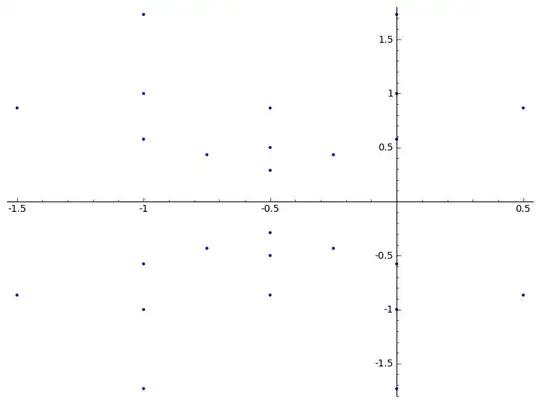In this answer, I proved the following statement:
For each positive integer $n$, there are finitely many non-rational complex numbers $x$ such that $x^n$ and $(x+1)^n$ are rational. These complex numbers all have the form $$x(a,b)=\frac{\zeta^b-\zeta^a}{1- \zeta^b},$$ where $\zeta$ is a primitive $n$th root of unity and $a,b$ are different nonzero elements of $\mathbb Z/n\mathbb Z$.
However, a search with a computer suggests that there are even finitely many such complex numbers over all $n$. I have counted $26$ of them.
Let $S_n$ be the set of non-rational complex numbers such that $x^n$ and $(x+1)^n$ are rational. Since $x^{nm}$ and $(x+1)^{mn}$ are rational if $x^n$ and $(1+x)^n$ are, it follows that $S_n \subseteq S_{nm}$. Let $S= \varinjlim S_{n!}$. This is the set of all non-rational complex numbers $x$ for which there exists an $n$ such that $x^n$ and $(x+1)^n$ are rational.
Question: Is $S$ finite?
I have checked with a computer that
$$S_{12}=S_{4!} = S_{5!}=S_{6!}$$ and that $S_n \subseteq S_{12}$ for $n<100$.
Question Is $S=S_{12}$? In other words, if $x^n$ and $(x+1)^n$ are rational, is it true that $x^{12}$ and $(x+1)^{12}$ are rational?
Micah has remarked in a comment to David's answer that any $s \in S$ must be a quadratic irrational. So, the finiteness of $S$ would follow if one could prove that finitely many numbers of the form $x(a,b)$ are quadratic irrationals. In order for this to be true, it must be that $x(a,b)^{\sigma^2} = x(a,b)$ for any $\sigma \in \text{Gal}(\mathbb Q(\zeta)/\mathbb Q) = (\mathbb Z/n\mathbb Z)^\times$. This means that we must have
$$\frac{\zeta^{c^2b}-\zeta^{c^2a}}{1- \zeta^{c^2b}} = \frac{\zeta^b-\zeta^a}{1- \zeta^b}$$ for any $c \in (\mathbb Z/n\mathbb Z)^\times$. Perhaps someone can extract an explicit condition on $(a,b)$ from this?...
The set $S_{12}$ consists of $26$ complex numbers. Here is a list of them (here written in terms of a primitive $24$th root of unity $\zeta$):
$$-1/3\zeta^4 - 1/3$$
$$-1/2\zeta^4 - 1/2$$
$$-2/3\zeta^4 - 2/3$$
$$-\zeta^4 - 1$$
$$-1/2\zeta^6 - 1/2$$
$$-\zeta^6 - 1$$
$$\zeta^4$$
$$-1/2\zeta^4$$
$$-\zeta^4$$
$$-2\zeta^4$$
$$2\zeta^4 - 1$$
$$\zeta^6$$
$$2/3\zeta^4 - 1/3$$
$$-2/3\zeta^4 + 1/3$$
$$-\zeta^6$$
$$-2\zeta^4 + 1$$
$$2\zeta^4 - 2$$
$$z^4 - 1$$
$$1/2\zeta^4 - 1/2$$
$$-\zeta^4 + 1$$
$$\zeta^6 - 1$$
$$1/2\zeta^6 - 1/2$$
$$\zeta^4 - 2$$
$$2/3\zeta^4 - 4/3$$
$$1/2\zeta^4 -1$$
$$1/3\zeta^4 - 2/3$$
Here is where they lie in the complex plane:

Here is a brief preview of the behavior of the function $f(n):=\#S_n$, as a plot of $f(n)$ for $n=2$ to $n=100$:
